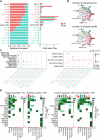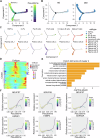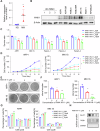Single-cell sequencing analysis of multiple myeloma heterogeneity and identification of new theranostic targets
- PMID: 39271659
- PMCID: PMC11399131
- DOI: 10.1038/s41419-024-07027-4
Single-cell sequencing analysis of multiple myeloma heterogeneity and identification of new theranostic targets
Abstract
Multiple myeloma (MM) is a heterogeneous and incurable tumor characterized by the malignant proliferation of plasma cells. It is necessary to clarify the heterogeneity of MM and identify new theranostic targets. We constructed a single-cell transcriptome profile of 48,293 bone marrow cells from MM patients and health donors (HDs) annotated with 7 continuous B lymphocyte lineages. Through CellChat, we discovered that the communication among B lymphocyte lineages between MM and HDs was disrupted, and unique signaling molecules were observed. Through pseudotime analysis, it was found that the differences between MM and HDs were mainly reflected in plasma cells. These differences are primarily related to various biological processes involving mitochondria. Then, we identified the key subpopulation associated with the malignant proliferation of plasma cells. This group of cells exhibited strong proliferation ability, high CNV scores, high expression of frequently mutated genes, and strong glucose metabolic activity. Furthermore, we demonstrated the therapeutic potential of WNK1 as a target. Our study provides new insights into the development of B cells and the heterogeneity of plasma cells in MM and suggests that WNK1 is a potential therapeutic target for MM.
© 2024. The Author(s).
Conflict of interest statement
The authors declare no competing interests.
Figures






Similar articles
-
The role of proliferating stem-like plasma cells in relapsed or refractory multiple myeloma: Insights from single-cell RNA sequencing and proteomic analysis.Br J Haematol. 2024 Sep;205(3):1031-1043. doi: 10.1111/bjh.19486. Epub 2024 Apr 26. Br J Haematol. 2024. PMID: 38671576
-
PTTG1 expression is associated with hyperproliferative disease and poor prognosis in multiple myeloma.J Hematol Oncol. 2015 Oct 6;8:106. doi: 10.1186/s13045-015-0209-2. J Hematol Oncol. 2015. PMID: 26445238 Free PMC article.
-
The cellular architecture of multiple myeloma.Cell Cycle. 2012 Oct 15;11(20):3715-7. doi: 10.4161/cc.22178. Epub 2012 Sep 14. Cell Cycle. 2012. PMID: 22983005 Free PMC article. No abstract available.
-
Myeloma stem cell concepts, heterogeneity and plasticity of multiple myeloma.Br J Haematol. 2013 Dec;163(5):551-64. doi: 10.1111/bjh.12563. Epub 2013 Sep 20. Br J Haematol. 2013. PMID: 24111932 Review.
-
Molecular pathogenesis of multiple myeloma: chromosomal aberrations, changes in gene expression, cytokine networks, and the bone marrow microenvironment.Recent Results Cancer Res. 2011;183:39-86. doi: 10.1007/978-3-540-85772-3_3. Recent Results Cancer Res. 2011. PMID: 21509680 Review.
References
MeSH terms
Grants and funding
LinkOut - more resources
Full Text Sources
Medical

